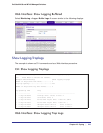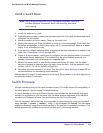
Chapter 19. Switch Stacks | 351
ProSafe M4100 and M7100 Managed Switches
1. The switch that is currently the stack master.
2. The switch with the highest stack member priority value.
Note: NETGEAR recommends assigning the highest priority value to the
switch that you prefer to be the stack master. This ensures that the
switch is re-elected as stack master if a re-election occurs.
3. The switch with the higher MAC address.
A stack master retains its role unless one of these events occurs:
• The stack master is removed from the switch stack
• The stack master is reset or powered off
• The stack master has failed
• The switch stack membership is increased by adding powered-on standalone switches or
switch stacks
In the case of a master re-election, the new stack master becomes available after a few
seconds. In the meantime, the switch stack uses the forwarding tables in memory to
minimize network disruption. The physical interfaces on the other available stack members
are not affected while a new stack master is elected. If a new stack master is elected and the
previous stack master becomes available, the previous stack master does not resume its role
as stack master.
Stack Members
A switch stack has up to 8 stack members connected through their stacking ports. A switch
stack always has one stack master.
A standalone switch is a switch stack with one stack member that also operates as the stack
master. You can connect one standalone switch to another to create a switch stack
containing two stack members, with one of them being the stack master. You can connect
standalone switches to an existing switch stack to increase the stack membership.
The operation of the switch stack continues uninterrupted during membership changes
unless you remove the stack master or you add powered-on standalone switches or switch
stacks.
Stack Member Numbers
A stack member number (1 to 8) identifies each member in the switch stack. The member
number also determines the interface-level configuration that a stack member uses. You can
display the stack member number by using the show switch user EXEC command.
A new, out-of-the-box switch (one that has not joined a switch stack or has not been manually
assigned a stack member number) ships with a default stack member number of 1. When it


















